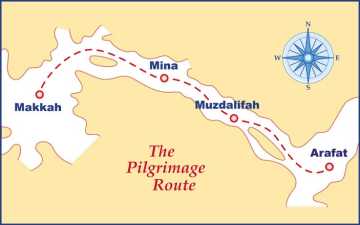Practical Hajj Guide

In the Name of Allâh, the Most Beneficent, the Most Merciful
Performing the Hajj
Performing the Hajj 1 - Eighth Thul Hijjah (1st Day of Hajj)

Eighth Thul Hijjah (1st Day of Hajj)
*The eight day of Thul Hijjah is known as Yawm at-Tarwiyah.
*For the one doing Hajj at-Tamattu’, then before entering the state of ihraam it is prescribed for them to do the following: take a bath, clip nails, trim moustache, remove unwanted hair (armpits and pubic) and wear two pieces of white cloth (towels/sheets). However, women wear “normal” clothing without wearing gloves or the niqaab. As for the one doing Qiraan or Ifraad, they are already in ihraam so they cannot trim their hair or clip nails etc…
*At the time of Dhuhaa (late morning), make your intention for Hajj from the place you are at (i.e. residence) saying Labbayka Hajjan
*If you fear that something may prevent you from completing the Hajj, then place the following condition upon intending the Hajj: (and if I am prevented by an obstacle then indeed my place is where You prevented me). If you do not have such a fear, then don’t place this condition.
**After intending Hajj, you must refrain from doing those things which are prohibited while in ihraam.
*Recite the talbiyah often:

Continue saying it until you pelt the large Jamarah (stone pillar) on the tenth of Thul Hijjah.
*Proceed towards Minaa while reciting the talbiyah and offer Thuhr, ‘Asr, Maghrib, ‘Ishaa and Fajr at Mina (all at their appointed times). Shorten the prayers (two raka’ah for the ones which are normally 4) but do not combine them. This applies to everyone.

*Be keen to recite the athkaar (words of remembrance) after the prescribed prayers as well as the athkaar of the morning and evening.
*Sleep the night in Minaa.

Some Errors Committed on the Eighth
1. Not educating oneself about the proper manner of performing Hajj (through authentic books and asking scholars). Rather, we find that many people set out for the Hajj and make their way through it looking at what others (laypeople) are doing. It is as though they are saying: ”I’ll do as I see the people doing”. This is true ignorance and those who err due to this attitude will not be excused. Allaah has made it a duty on us to seek knowledge concerning that which we are ignorant of as He says:
 …so ask the people of the message (i.e. scholars) if you do not know. (21:7)
…so ask the people of the message (i.e. scholars) if you do not know. (21:7)
2. Many pilgrims expose their right shoulders from this day until the end of the Hajj, but this is incorrect as this act is only prescribed at the time of the initial tawaaf (al-qudoom).
3. Many women think that their ihraam clothing must be of a particular colour (white or green for example), but this is incorrect. Rather, she wears “ordinary” clothing, observing the rules of hijaab and refraining from wearing gloves and the niqaab (as stated previously).
4. Some pilgrims prepare themselves for the ihraam by doing things forbidden in the Sharee’ah such as shaving their beards and wearing the lower garment below the ankles. These are forbidden and diminish the rewards of the Hajj.
5. Some pilgrims do not spend the night in Minaa, but rather proceed directly on this night to ‘Arafah. This conflicts with the guidance of the Prophet (sallallaahu ‘alayhi wa sallam).
6. Many pilgrims supplicate using supplications they do not understand nor know the source of. Very often, they simply repeat supplications found in books that happen to fall into their hands. However, one should supplicate using authentic supplications found in the Quraan and Sunnah as well as supplicating in one’s own language, asking for what they need from the bottom of their hearts.




